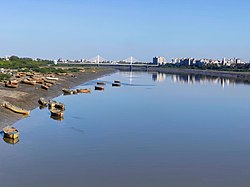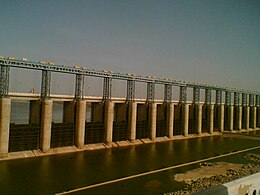| Tapti Tapi | |
|---|---|
 | |
| Location | |
| Country | India |
| State | Madhya Pradesh, Maharashtra, Gujarat |
| Physical characteristics | |
| Source | Multai, Madhya Pradesh |
| Mouth | Gulf of Khambhat (Arabian Sea) |
• location | Dumas, Surat, Gujarat |
| Length | 724 km (450 mi)approx. |
| Basin size | 62,225 square kilometres (24,025 sq mi) |
| Discharge | |
| • location | Dumas Beach[1] |
| • average | 489 m3/s (17,300 cu ft/s) |
| • minimum | 2 m3/s (71 cu ft/s) |
| • maximum | 9,830 m3/s (347,000 cu ft/s) |
| Basin features | |
| Tributaries | |
| • left | Girna, Nesu, Amravati, Buray, Panjhara, Bori, Waghur, Purna, Mona, Sipna |
| • right | Vaki, Aner, Arunawati, Gomai |
The Tapti River (or Tapi) is a river in central India located to the south of the Narmada river that flows westwards before draining into the Arabian Sea.[2] The river has a length of around 724 km (450 mi) and flows through the states of Maharashtra, Gujarat and Madhya Pradesh.[2] It flows through the city of Surat, in Gujarat, and is crossed by the Magdalla, ONGC Bridge.[3]

On 7 August 1968, before the construction of the Ukai Dam to bring its waters under control and provide hydroelectric power, the Tapti River overflowed its banks during heavy rains in the monsoon season. More than 1,000 people drowned in the flood,[4] and the city of Surat was submerged beneath 10 feet of water for several days.[5] After the floodwaters receded, at least 1,000 more people died in Gujarat during a cholera epidemic from the contamination of the drinking water.[6] The Tapti basin covers parts of Madhya Pradesh, Gujarat and Maharashtra.[citation needed]
